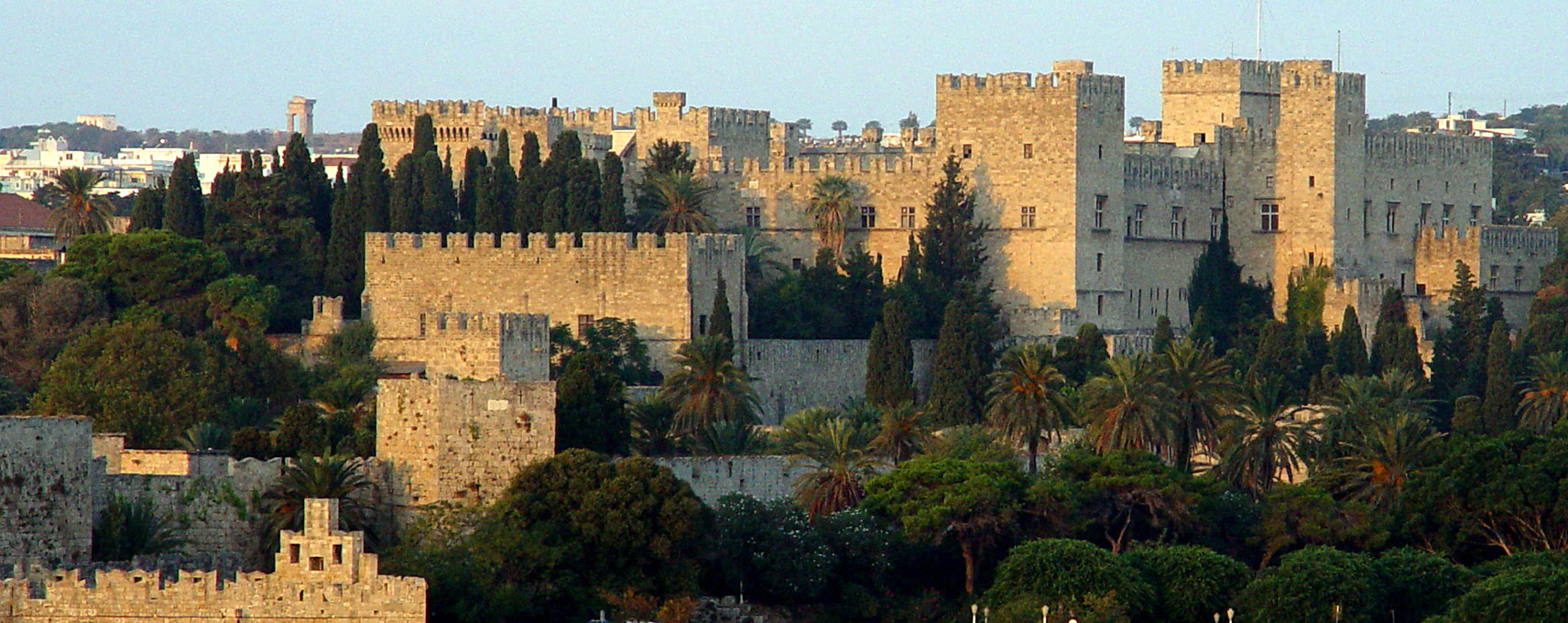Medieval City

The main gates are:
* D' Amboise Gate to the northwest.
* Saint Athanasios Gate to the southwest.
* Koskinou Gate to the south, also known as Kokkini Porta (Red Gate).
* Agia Aikaterini (Saint Catherine's) Gate, leading to the harbor.
* The Sea Gate (Porta Marina) stands facing the central harbor is the most beautiful of all the gates.
* Agios Pavlos (Saint Paul's) Gate to the north, leading to Mandraki.
These gates (including some secondary ones) lead to the interior which is, in turn, divided into two sectors: the "Collachium" (or Kollakio), where the Knights lived and where the most important Knights' houses are still to be found and the "Burgh" (or Hora), the main city.
Walking the cobbled streets the visitor can admire the magnificent buildings of the Knights, the moat and walls with their ramparts, the Byzantine churches and the mosques, the squares, the gardens and the courtyards of the houses.
The feeling is very much as though the clock has stopped somewhere in the past, but at the same time, the visitor discovers that this unique complex is a vibrant town, full of surprises and just crying out for exploration.
The Street of the Knights (Ippoton Street)
Leaving Symi Square and passing through Argyrokastro Square (the old arsenal of the Knights stands here) we end up to Alexander the Great Square. From Alexander the Great Square, just before the Museum Square and in front of the Church of the Virgin Mary of the Castle, begins the famous Street of the Knights (Ippoton), the most important and imposing street in the Collachium, leading to the Grand Master's Palace.
It is a cobbled street, lined on both sides with the Inns (headquarters) of the various nationalities ("tongues") of the Order of the Knights. Walking up, you pass the north aspect of the museum (left) and the Inns of the Tongues of Italy and France (with its little chapel and gothic statue of the Virgin Mary holding the infant Christ).
Beyond the arch are the Inns of the Tongues of Provence (right) and Spain (left). The Street of the Knights ends under a large gothic arcade with peristyle, having passed two further Inns.
The Palace of the Grand Master
The Palace of the Grand Master of the Order, the famous "Castello" is the most imposing edifice in the old town. It was the headquarters of the leader of the Order of the Knights of Saint John and, at the same time, a strong fortress.
It was built in the 14th century on the ruins of a Byzantine fort. It consists of two storeys with a large internal courtyard. It was destroyed in the period of Turkish rule and rebuilt in the 1930's in the magnificent style that we see now.
Today the Palace is a museum and its many rooms contain important archaeological findings from ancient and medieval Rhodes.
- Statues from the Hellenistic and Roman periods, removed from the ancient music school on Kos, stand in the courtyard.
- In the right hand wing of the ground floor are three halls decorated with frescoes by the painter Venlia (1940).
- The corridor in front of the chapel of the Annunciation (1940) leads to the ground floor exhibition salons.
- A wide, generous, staircase leads to the first floor, where visitors can marvel at the splendid décor.
- Many of the separately named first floor rooms contain floor mosaics, furniture, statues, vases, icons and other luxurious artifacts.
Hippocrates ´ Square
Hippocrates' Square at the end of Socrates Street, the main shopping thoroughfare of the Old Town. Around the square are many bars, restaurants and nightclubs.
The Panagia (Virgin Mary) of the Burgh
The church of the Panagia (Virgin Mary) of the Burgh is a late gothic structure of the 14th century. Bombed in the Second World War, only the sanctuary's three apses remain standing today.
The Melina Mercouri Theater at the Medieval City
The Melina Mercouri theatre appears in the moat of the medieval town. Beneath the magic scenery of the ramparts, towers and walls, take place summer concerts, plays and dance performances.






